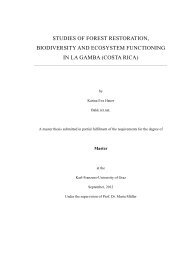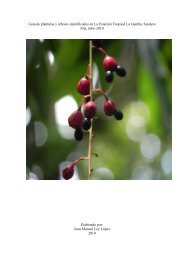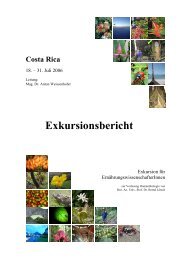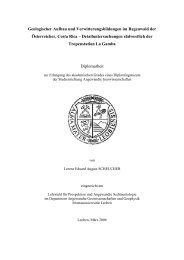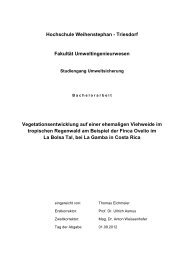Leaf colour patterns, vegetative and sexual reproduction of Episcia ...
Leaf colour patterns, vegetative and sexual reproduction of Episcia ...
Leaf colour patterns, vegetative and sexual reproduction of Episcia ...
You also want an ePaper? Increase the reach of your titles
YUMPU automatically turns print PDFs into web optimized ePapers that Google loves.
determine the tissues where the anthocyanins are located. This gives indications about the<br />
possible function.<br />
As <strong>Episcia</strong> lilacina is solely found on the ground it is <strong>of</strong> interest if there are any differences in<br />
the amount <strong>of</strong> light that is adsorbed from the diverse leaf-morphs. Does less light get to the<br />
ground where the plants develop darker leaves? Do the anthocyanins enhance the light<br />
adsorption within the leaves? Do the <strong>patterns</strong> <strong>of</strong> the leaves change if the plants were transferred<br />
to a new habitat? All these questions will be answered in the second part <strong>of</strong> this work.<br />
The Genus <strong>Episcia</strong> - Systematics <strong>and</strong> General Characteristics<br />
The family <strong>of</strong> the Gesneriaceae is spread in the tropics <strong>and</strong> subtropics <strong>of</strong> the Old <strong>and</strong> New<br />
World, but it also appears in the warm-temperate regions in Eastern Asia <strong>and</strong> Europe. Pantropically<br />
there are 147 genera with 3870 species. In the Neotropics there are approximately 40<br />
genera with more than 900 species: for example Alloplectus (75), Besleria (over 200), Codonanthe<br />
(17), Columnea (396), Diastema (20), Drymonia (over 140), <strong>Episcia</strong> (9), Gasteranthus (35), Gesneria (60),<br />
Kohleria (17), Nautilocalyx (over 70), Paradrymonia (over 70), Sinningia (60). In Costa Rica there are<br />
29 genera with more than 140 species within the Gesneriaceae.<br />
The representatives <strong>of</strong> the family Gesneriaceae are perennial (seldom annual) herbs, shrubs or<br />
small trees. In the Neotropics lives a huge number <strong>of</strong> species epiphytically, while in the<br />
Palaeotropics most species are terrestrial. The leaves are opposite <strong>and</strong> <strong>of</strong>ten arranged anisophylly,<br />
distichally or spirally. They are sometimes fleshy <strong>and</strong> pilose; the lamina is usually undivided, very<br />
rarely lobed or pinnately dissected. The inflorescences are mostly axillary cymes with the flowers<br />
placed in pairs. The flowers are mostly zygomorphic, rarely actinomorphic <strong>and</strong> usually 5-merous.<br />
The sepals are free or conate to a variable extent. The petals are sympetalous with a more or less<br />
long tube. They own from two to four (rarely five) stamens with <strong>of</strong>ten-coherent anthers. The<br />
filament is always adnate to the corolla. The ovary is mostly superior or also semi-inferior to<br />
inferior. The placentation is parietal; the stigma is capitate, bilabiate or variously bifid. The fruits<br />
are fleshy berries or capsules, which open by two or four valves or by a dorsal slit. The seeds are<br />
very numerous <strong>and</strong> very small (Morton 1938, 1971).<br />
The family is divided into four subfamilies:<br />
1. The subfamily <strong>of</strong> Didymocarpoideae (82 genera/over 2000 species) has representatives in<br />
Africa, Madagascar, from Sri Lanka to Malaysia <strong>and</strong> in the pacific region, isolated also in<br />
Europe. Some genera are: Cyrt<strong>and</strong>ra, Henckelia, Aeschynanthus, Streptocarpus, Agamyla, Paraboea,<br />
Didymocarpus.<br />
13





